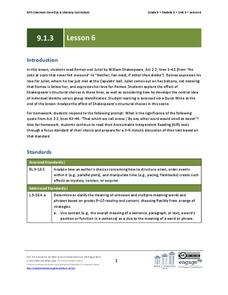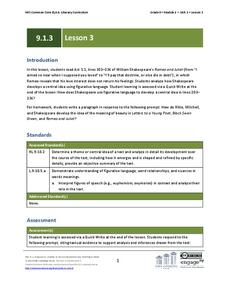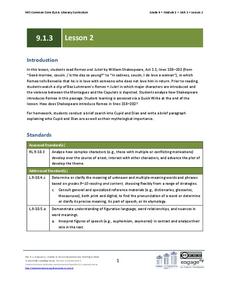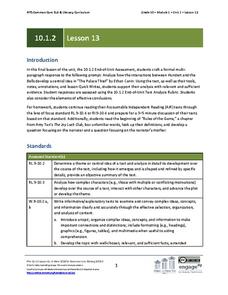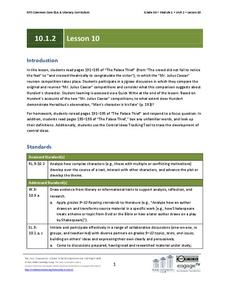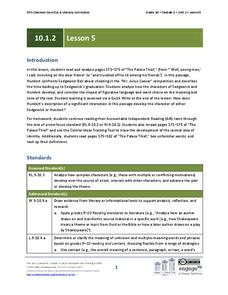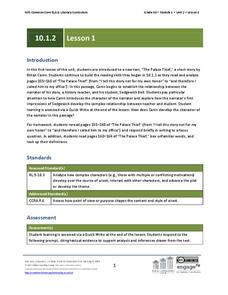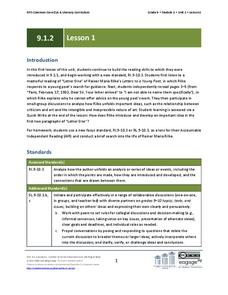EngageNY
Grade 9 ELA Module 1: Unit 3, Lesson 6
The balcony scene from Romeo and Juliet takes center stage as class members consider the structural choices Shakespeare makes, i.e., having Romeo appear first in the scene and having Juliet appear unaware that Romeo is listening to her...
EngageNY
Grade 9 ELA Module 1: Unit 3, Lesson 5
Class members continue their study of Romeo and Juliet by watching scenes from Baz Luhrmann’s Romeo + Juliet and then examining the figurative language Shakespeare uses in Act 1, scene 5, lines 92–109 when Romeo and Juliet meet at the ball.
EngageNY
Grade 9 ELA Module 1: Unit 3, Lesson 4
Class members watch the clip of Baz Luhrmann’s Romeo + Juliet in which Benvolio persuades Romeo to go with him to the Capulet ball to see Rosaline. Pairs then examine Act 1, scene 3, lines 64–100, and consider how Shakespeare develops...
EngageNY
Grade 9 ELA Module 1: Unit 3, Lesson 3
Class members listen to a masterful reading of Act 1, Scene 1, lines 203-236 of Romeo and Juliet and then break into groups to examine how Shakespeare uses figurative language to develop Romeo's idealized concept of beauty.
EngageNY
Grade 9 ELA Module 1: Unit 3, Lesson 2
After viewing a clip from Baz Luhrmann’s Romeo + Juliet in which major characters are introduced, and the violence between the Montagues and the Capulets is depicted, the class reads Act 1, Scene 1, lines 158-202. Groups then analyze the...
EngageNY
Grade 10 ELA Module 1: Unit 2, Lesson 13
To conclude their study of Ethan Canin’s short story “The Palace Thief,” class members use their notes and annotations to craft an expository essay response to the prompt, "Analyze how the interactions between Hundert and the Bells...
EngageNY
Grade 10 ELA Module 1: Unit 2, Lesson 12
As the class concludes its close reading of “The Palace Thief,” groups consider how the narrator's character has changed throughout Ethan Canin’s short story.
EngageNY
Grade 10 ELA Module 1: Unit 2, Lesson 10
Is man's character his fate? Can actions change character? To track the development of the central ideas in Ethan Canin’s short story “The Palace Thief,” groups compare Hundert's actions in the original "Mr. Julius Caesar" competition...
EngageNY
Grade 10 ELA Module 1: Unit 2, Lesson 9
Do our childhood circumstances significantly shape us? As the close reading of “The Palace Thief” continues, groups examine how the results of the first "Mr. Julius Caesar" competition influenced the development of the characters in...
EngageNY
Grade 10 ELA Module 1: Unit 2, Lesson 7
As a mid-unit assessment of a series of lessons that use Ethan Canin’s short story “The Palace Thief” as an anchor text, writers craft an in-class essay discussing how Hundert's character has developed throughout the text.
EngageNY
Grade 10 ELA Module 1: Unit 2, Lesson 8
Now what? Class members continue their close reading of Ethan Canin’s short story “The Palace Thief,” focusing on Hundert's feelings about his retirement, and consider what these feelings reveal about his character.
EngageNY
Grade 10 ELA Module 1: Unit 2, Lesson 5
Readers of "The Palace Thief" focus on how the author's descriptions and word choices reveal the characters of the narrator, Sedgewick, and the senator.
EngageNY
Grade 10 ELA Module 1: Unit 2, Lesson 2
Class members continue their reading of Ethan Canin's "The Palace Thief," focusing on how the relationship between the narrator and Sedgewick changes after the narrator meets Sedgewick's father.
EngageNY
Grade 10 ELA Module 1: Unit 2, Lesson 1
The complex relationship between a teacher and his student takes center stage in an instructional activity that asks readers to pay close attention to how author Ethan Canin introduces his characters and how he develops the character of...
EngageNY
Grade 10 ELA Module 1: Unit 3, Lesson 14
A thorough unit on literary analysis and character development culminates in a final writing assessment. Prompted to compare the parent-child relationships in Amy Tan's The Joy Luck Club and H.G. Bissinger's Friday Night Lights, high...
EngageNY
Grade 10 ELA Module 1: Unit 3, Lesson 8
Prepare for a mid-unit assessment based on Amy Tan's The Joy Luck Club with a brainstorming and discussion lesson plan. Focused on two chapters from the novel ("Rules of the Game" and "Two Kinds"), the lesson plan guides tenth graders...
EngageNY
Grade 10 ELA Module 1: Unit 3, Lesson 7
Track character development with an excerpt from Amy Tan's The Joy Luck Club. As tenth graders examine the relationship between Jing-Mei and her mother, they compare both characters' expectations of each other in the chapter "Two Kinds."
EngageNY
Grade 10 ELA Module 1: Unit 3, Lesson 5
Even the most rigid expectations come from a place of deeply held values. In a key chapter of Amy Tan's The Joy Luck Club, explore the ways that Jing-Mei's mother's parental expectations affect her relationship with Jing-Mei. Tenth...
EngageNY
Grade 10 ELA Module 1: Unit 3, Lesson 4
Vivid quotes and strong sensory language compose Amy Tan's The Joy Luck Club, bringing the women to life as they navigate through issues surrounding identity and maternal relationships. Examine Waverly's relationship with her mother...
EngageNY
Grade 10 ELA Module 1: Unit 3, Lesson 1
The Joy Luck Club by Amy Tan is an illustrative source of rich prose, deep character development, and strong literary themes. Use two of the book's key chapters, which focus on Waverly's relationship with chess and with her mother, to...
EngageNY
Grade 9 ELA Module 1, Unit 2, Lesson 7
Readers analyze David Mitchell's techniques for introducing and developing the mystery surrounding Madame Crommelynck in the "Solarium" chapter of his novel Black Swan Green.
EngageNY
Grade 9 ELA Module 1, Unit 2, Lesson 6
Guided by the provided questions, readers of David Mitchell's "Hangman" examine the author's figurative language to develop the constant struggle in Jason and Hangman's relationship.
EngageNY
Grade 9 ELA Module 1, Unit 2, Lesson 5
How does word choice influence the meaning and tone of a text? To answer this question, class members listen to a masterful reading of a passage from David Mitchell's Black Swan Green and then work with a partner to conduct a close...
EngageNY
Grade 9 ELA Module 1, Unit 2, Lesson 1
Where does a writer find inspiration? "Go into yourself," says Rainer Maria Rilke in "Letter One" from Letters to a Young Poet. Readers of Rilke's letter to Franz Xaver Kappus examine the words and figurative language Rilke uses to...
